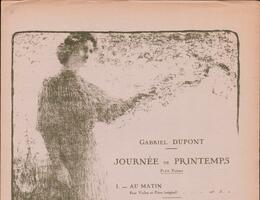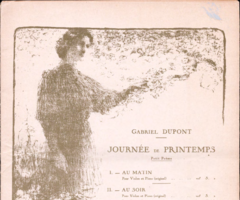Journée de printemps [Spring Day]
Au matin [In the Morning] – Au soir [In the Evening]
In June 1899 after his composition class examinations at the Conservatory, Charles-Marie Widor merely wrote next to Gabriel Dupont’s name: “A musician with a future”. Indeed, fortune seemed to smile at the young 21-year old artist: while still a student he had already won an award offered by the city of Nancy for the composition of a symphonic poem – Summer Day, in three movements: “Sunny morning”, “Woodland undergrowth” and “Nocturne” – first performed in March 1900 conducted by Guy Ropartz. Spring Day, a piece for violin and piano composed at the same time and published in 1901 by Leduc, is drawn from the same source of inspiration, proposing to express seasonal impressions in two movements. While scattered elements, like the aquatic flow of the piano, lead us to imagine that the summer day is unfolding in the countryside, next to a river, in the heart of a budding, lusty Nature, the composer was careful not to suggest too explicit a programme for his piece. In a strictly Belle Époque style Gabriel Dupont played above all on instrumental colour to suggest the particular features of a mild climate, shifting but never threatening. The subtitle he suggested for the publication – “Small poem for violin and piano” - seems moreover an emphatic tribute to Ernest Chausson, recently lamented (Poem of Love and the Sea for Voice and Orchestra; Poemfor violin and orchestra). The Autumn Poems cycle (1904)and the Winter Day and Summer Twilight melodies (1905 and 1912) will subsequently come to complete Dupont’s vision of the seasons.



